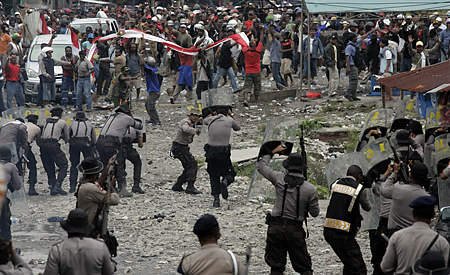
Police fire warning shots in the air to disperse protesters from Freeport-McMoRan Copper and Gold Inc's Grasberg mine during a demonstration in Timika of Indonesia's Papua province, October 10, 2011. (Photo: Muhammad Yamin / Reuters)
Rights groups are calling on Indonesia to investigate the fatal shooting of gold and copper mine workers in eastern Indonesia. In a gruesome escalation of a dispute between U.S.-based Freeport-McMoRan and workers from their Grasberg mine, security forces opened fire on a crowd of strikers, killing one man and injuring more than a dozen others. “This latest incident shows that Indonesian police have not learned how to deal with protesters without resorting to excessive, and even lethal, force,” said Amnesty International’s Sam Zarifi in a statement published online. “The authorities must launch an independent and impartial investigation into this tragedy.”
The violence, though tragic, is hardly surprising. Grasberg, which holds one of the world’s largest reserves of gold and copper, has frequently seen protests over wages, working conditions and public accountability. About 8000 of the site’s workers have been on strike since Sept. 15, demanding that their pay, which reportedly ranges from $1.5 to $3.00 an hour, be raised significantly. An eight-day strike in July crippled the mine, contributing to a global rise in copper prices.
The fight at Grasberg is, in many ways, about the fight for Papua itself. The western part of the island of New Guinea was once a Dutch colony, but has been Indonesian territory since a highly contested 1969 plebiscite known as the “Act of Free Choice.” Much of the indigenous Melanesian population opposes Indonesian rule and see the government—and their allies at Freeport—as occupiers.
The massive mining operation has long been a flashpoint in the conflict. Over the years, there have been periodic episodes of violence and reports of environmental abuse. In 2005, the New York Times described “a spreading soot-colored bruise of almost a billion tons of mine waste” (That account was based on satellite images, because reporters are banned from Papua.) Their investigation also found that Freeport had unusually close ties to the Indonesian military, an organization with a “blighted” history of rights abuses. In a recent op-ed for the Guardian, Benny Wenda, an exiled Papuan independence leader, said companies like Freeport legitimize Indonesian rule while giving little back to the community. “While they have profited from our natural resources, my people have been subjected to nearly 50 years of oppression, hardship and poverty,” he writes.
Both Freeport and Jakarta insist that mining benefits the region. In a statement released Sept. 21, the company called their compensation packages “highly competitive” and noted that between taxes, wages and procurement, the firm contributed $3.8 billion to the Indonesian government in 2010. They blamed the strikers for the instigating violence—a version of events backed by local police, but denied by workers representatives. On Tuesday, Reuters reported that the protesters may lower their wage demands to $7.50 per hour from a previous demand of at least $12.50 per hour. That may bring them closer to a settlement. For Papua, though, there is no deal in sight.
Emily Rauhala is an Associate Editor at TIME. Find her on Twitter at @emilyrauhala. You can also continue the discussion on TIME’s Facebook page and on Twitter at @TIME.
